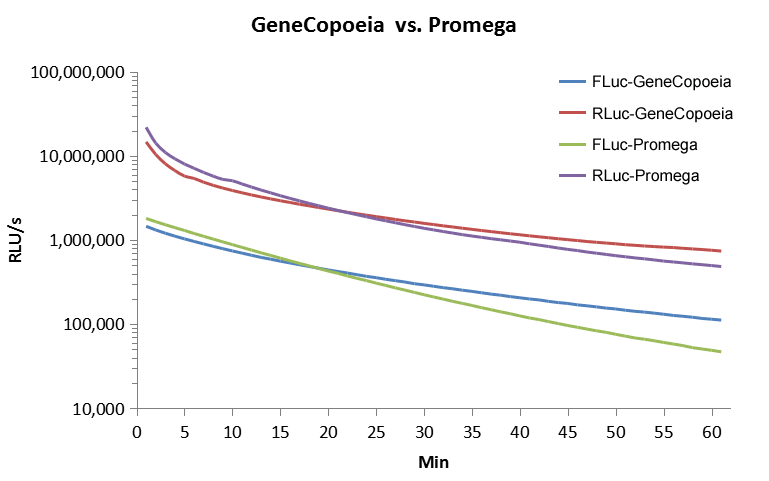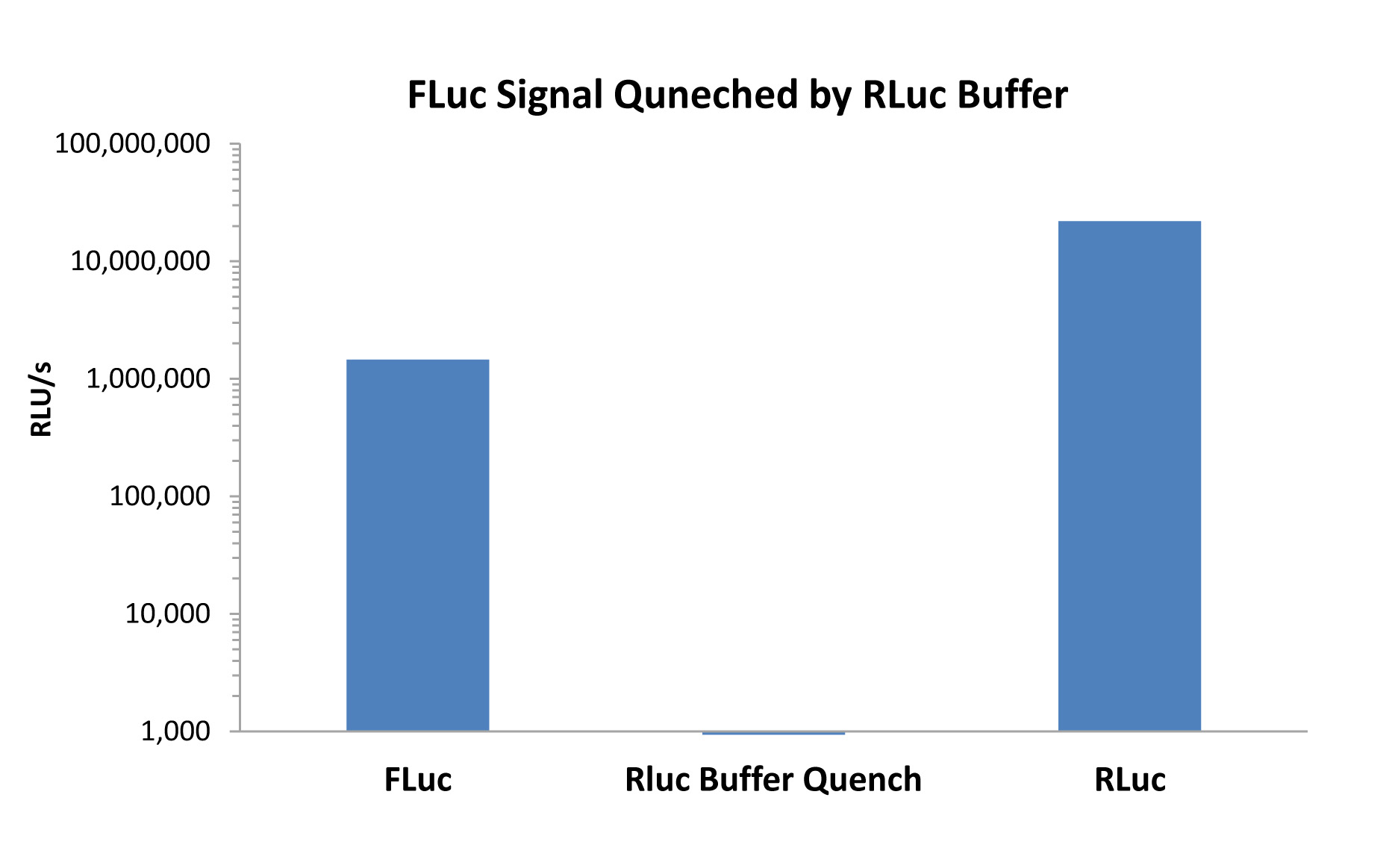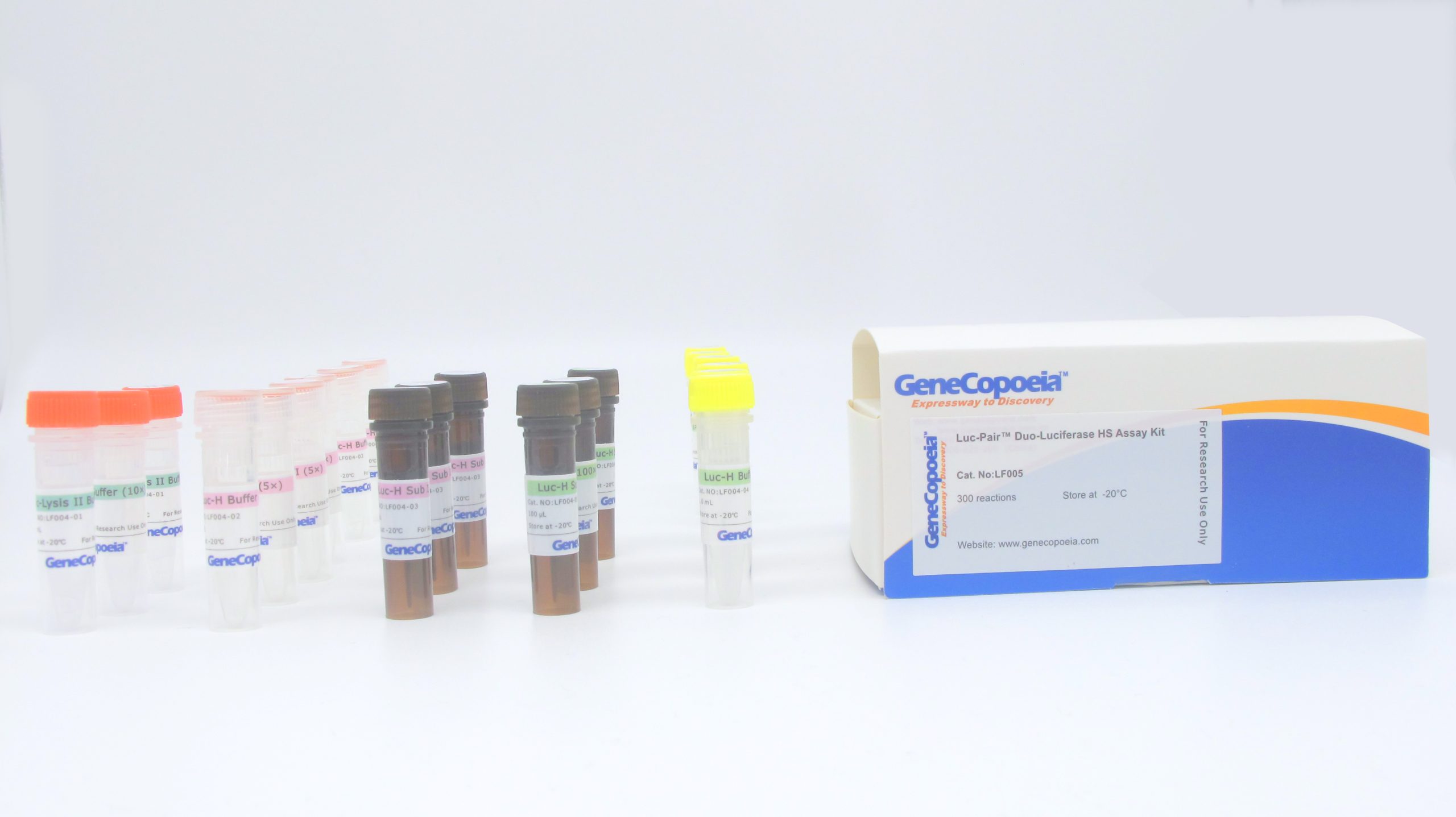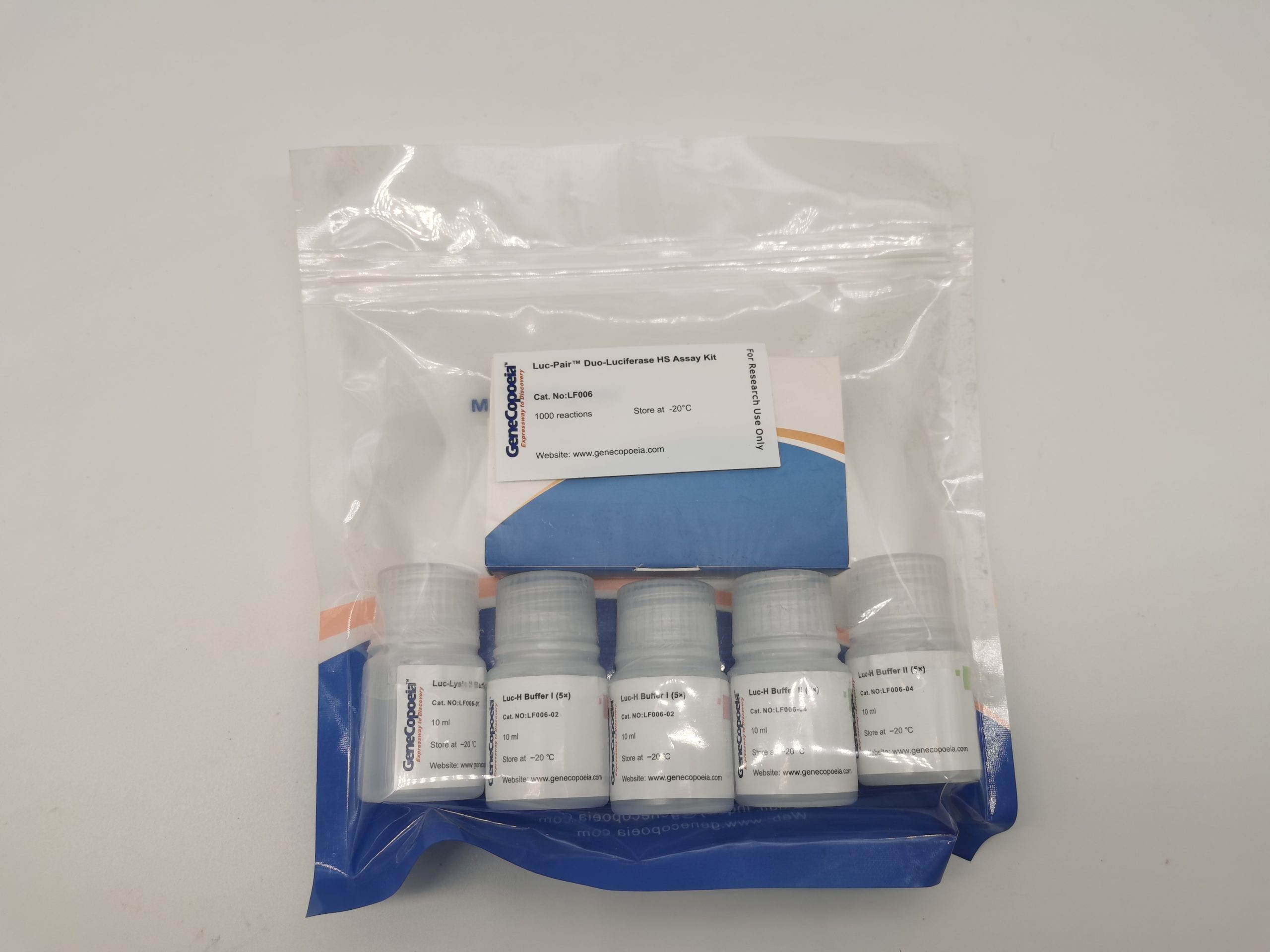Introduction
GeneCopoeia’s Luc-Pair™ Duo-Luciferase HS Assay Kit is the perfect choice for high sensitivity detection of Firefly luciferase (FLuc) and Renilla luciferase (Rluc) activities. The Luc-Pair™ Duo-Luciferase HS Assay Kit works great for many different eukaryotic cell types (e.g. mammalian, invertebrates, etc.) using micro-plate or single-tube luminometers, and is compatible with GeneCopoeia, Promega and many other Fluc and Rluc vectors. The Luc-Pair™ Duo-Luciferase HS Assay Kit is ideal for many applications, such as measuring the inhibitory effect of a miRNA on a target sequence.
Advantages
- High sensitivity — Reagents are optimized for greatest sensitivity of Firefly and Renilla luciferase signals (Figure 1).
- Versatility — Designed for assays with many different eukaryotic cell types (e.g. mammalian, lower invertebrates, etc.) using micro-plates or single-tube luminometers.
- Low background — Very low background luminescence. No subtraction is required from readings.
- Simplicity — Renilla luciferase buffer and substrate contains the quencher for Firefly luciferase activity (Figure 2), enabling quick Glow and Stop-N-Glow two-step assays.
- Reproducibility — Reliable, linear results for a concentration range over several orders of magnitude.
- Compatibility — Compatible with Promega’s Fluc and Rluc vectors.
GeneCopoeia also offers the Luc-Pair™ Duo-Luciferase Assay Kit 2.0 for applications requiring luciferase readings with enhanced stability.

Figure 1. Activity of Firefly luciferase and Renilla luciferase signals using GeneCopoeia Luc-Pair™ Duo-Luciferase HS Assay Kit. HEK 293 cells were transfected with Promega pGL4.13/pGL4.75 reporter vectors for 48 hours. The FLuc (FLuc-GeneCopoeia) and RLuc (RLuc-GeneCopoeia) activity was measured as described in the procedure. The Promega dual-luciferase assay kit was used (FLuc-Promega and RLuc-Promega) for comparison.

Figure 2. Firefly luciferase activity is quenched with the addition of Luc-H Buffer II. HEK 293 cells were transfected with Promega pGL4.13/pGL4.75 reporter vectors for 48 hours. The firefly luciferase activity was measured as described in the procedure. Next, 1x Luc-H Buffer II (without or with substrate) was added to the wells, followed by count reading in a luminometer. About 99.9% of firefly luciferase activity was quenched (middle column).
To Order
To Order
Vector options (Discounted price – $199)
*Promotions are valid in the US & Canada only. For international customers, please contact your local distributors. Promotion ends January 31, 2025. Discounts are not valid on previous purchases and cannot be combined with additional discounts.
FAQs
Frequently Asked Questions: Luciferase Assays
Answer: “RLU” stands for “Relative Light Unit”. Luminometers do not measure light output, in terms of numbers of photons, directly.
Answer: All GeneCopoeia luciferase kits are compatible with all known luminometers.
Answer: All GeneCopoeia luciferase reagents are stable for at least 6 months if stored at -20°C.
Answer: To prevent loss of activity, it is best to avoid repeated freezing and thawing. We recommend pipetting small aliquots into new, clean, sterile tubes and placing those aliquots at -20°C. Once you have thawed one of the aliquots, discard it instead of putting it back in the freezer.
Answer: The Gaussia luciferase substrate, coelenterazine, is also the substrate for Renilla luciferase, so it is compatible with Renilla. However, coelenterazine cannot be used with Firefly (Photinus pyralis) luciferase, which instead uses luciferin as its substrate.
Answer: Unfortunately, the individual components of GeneCopoeia’s luciferase kits cannot be purchased separately at this time.
Answer: Typically, between 12 and 24 hours.
Answer: The
Luc-Pair™ Duo-Luciferase Assay Kit 2.0 (For Enhanced Stability),
Luc-Pair™ Duo-Luciferase Assay Kit HT (For High Throughput),
Luc-Pair™ Firefly Luciferase HT Assay Kit, and
Luc-Pair™ Renilla Luciferase HT Assay Kit (For High Throuhput), which provide greater signal stability, are most useful when assaying a relatively large number of samples. Their enhanced signal stability means that there will be little sample-to-sample variation due to signal decay. Conversely, the
Luc-Pair™ Duo-Luciferase HS Assay Kit (For High Sensitivity),
Luc-Pair™ Firefly Luciferase HS Assay Kit (For High Sensitivity), and
Luc-Pair™ Renilla Luciferase HS Assay Kit (For High Sensitivity) are used when maximal signal intensity is required, but the trade-off is that the signal decays more rapidly under typical laboratory conditions. These kits are not appropriate for measuring the activities of large numbers of samples, unless sample injectors are used.
Publications
View selected publications citing GeneCopoeia’s Luc‐Pair™ Firefly/Renilla luciferase HS assay kit from the recent literature
2025
- Zhao, S-S., et al. (2025). Neospora caninum infection specifically suppresses the expression of a host lncRNA XR_001919077.1 to facilitate parasite propagation by modulating host cell mitochondrial function and autophagy. Microbiol Spectr DOI: 10.1128/spectrum.01580-24 [Luc-Pair™ Duo-Luciferase HS Assay Kit]
- Zhang, Z., et al. (2025). Repurposing of phosphodiesterase-5 inhibitor sildenafil as a therapeutic agent to prevent gastric cancer growth through suppressing c-MYC stability for IL-6 transcription. Commun Biol DOI: 10.1038/s42003-025-07519-9 [Luc-Pair™ Duo-Luciferase HS Assay Kit, Cat. No. LF004]
- Cao, J., et al. (2025). Targeting estrogen-regulated system xc− promotes ferroptosis and endocrine sensitivity of ER+ breast cancer. Cell Death Dis DOI: 10.1038/s41419-025-07354-0 [Luc-Pair ™ Duo-Luciferase HS Assay Kit]
- Lin, Z., et al. (2025). Eriodictyol-cisplatin coated nanomedicine synergistically promote osteosarcoma cells ferroptosis and chemosensitivity. J Nanobiotechnology DOI: 10.1186/s12951-025-03206-3 [Luc-Pair™ Duo-Luciferase HS Assay Kit, Cat. No. LF004]
2024
- Kumar, V., et al. (2024). APOL1 Modulates Renin–Angiotensin System. Biomolecules DOI: 10.3390/biom14121575 [miTarget™ miRNA 3′ UTR clone targeting VDR and control, Cat. No. HmiT018474-MT06, CmiT000001-MT06; Luc-Pair™ Duo-Luciferase HS Assay Kit]
- Piredda, R., et al. (2024). Assessment of molecular modulation by multifrequency electromagnetic pulses to preferably eradicate tumorigenic cells. Sci Rep DOI: 10.1038/s41598-024-81171-x [Luc-Pair™ Duo-Luciferase HS Assay Kit]
- Reddy, D., et al. (2024). Morphine-induced hyperalgesia impacts small extracellular vesicle miRNA composition and function. bioRxiv DOI: 10.1101/2024.10.17.617815 [Luc-Pair™ Duo-Luciferase HS Assay Kit, Cat. No. LF004]
- Medhavy, A., et al. (2024). A TNIP1-driven systemic autoimmune disorder with elevated IgG4. Nat Immunol DOI: 10.1038/s41590-024-01902-0 [Luc-Pair™ Duo-Luciferase HS Assay Kit]
- Li, Y., et al. (2024). BRCC36 regulates β-catenin ubiquitination to alleviate vascular calcification in chronic kidney disease. J Transl Med DOI: 10.1186/s12967-024-05605-w [Luc-Pair™ Duo-Luciferase HS Assay Kit, Cat. No. LF004]
- Zheng, H., et al. (2024). BCAA mediated microbiota-liver-heart crosstalk regulates diabetic cardiomyopathy via FGF21. Microbiome. DOI: 10.1186/s40168-024-01872-3 [Luc-Pair™ Duo-Luciferase HS Assay Kit, Cat. No. LF004]
- Sunwoo, S-Y., et al. (2024). Deletion of MGF505-2R Gene Activates the cGAS-STING Pathway Leading to Attenuation and Protection against Virulent African Swine Fever Virus. Vaccines (Basel). DOI: 10.3390/vaccines12040407 [Luc-Pair™ Duo-Luciferase HS Assay Kit]
- Tanaka, L.Y., et al. (2024). Disturbed flow regulates protein disulfide isomerase A1 expression via microRNA-204. Front Physiol. DOI: 10.3389/fphys.2024.1327794 [Luc-Pair™ Firefly Luciferase HS Assay Kit; Luc-Pair™ Duo-Luciferase HS Assay Kit; miTarget™ miRNA 3′ UTR]
- Chen, J., et al. (2024). IL-22 signaling promotes sorafenib resistance in hepatocellular carcinoma via STAT3/CD155 signaling axis. Front Immunol. DOI: 10.3389/fimmu.2024.1373321 [Luc-Pair™ Duo-Luciferase HS Assay Kit, Cat. No.LF004]
- He, Z., et al. (2024). Exosomal long non-coding RNA TRPM2-AS promotes angiogenesis in gallbladder cancer through interacting with PABPC1 to activate NOTCH1 signaling pathway. Mol Cancer. DOI: 10.1186/s12943-024-01979-z [Luc-Pair™ Duo-Luciferase HS Assay Kit]
- Hu, L., et al. (2024). Exosomal MALAT1 promotes the proliferation of esophageal squamous cell carcinoma through glyoxalase 1-dependent methylglyoxal removal. Noncoding RNA Res. DOI: 10.1016/j.ncrna.2024.01.003 [Luc-Pair™ Duo-Luciferase HS Assay Kit, Cat. No. LF004]
- Merk, L., et al. (2024). Blocking TGF-β- and Epithelial-to-Mesenchymal Transition (EMT)-mediated activation of vessel-associated mural cells in glioblastoma impacts tumor angiogenesis. Free Neuropathol. DOI: 10.17879/freeneuropathology-2024-5188 [Luc-Pair™ Firefly Luciferase HS Assay Kit, Cat. No.LF007]
- Danlei Wang, et al. 2024. MicroRNA-218-5p-Ddx41 axis restrains microglia-mediated neuroinflammation through downregulating type I interferon response in a mouse model of Parkinson’s disease. J Transl Med. DOI: 10.1186/s12967-024-04881-w [Luc-Pair™ Duo-Luciferase HS Assay Kit]
2023
- Rachel Erickson, et al. 2023.SARS-CoV-2 infection of human lung epithelial cells induces TMPRSS-mediated acute fibrin deposition. Nat Commun. DOI:10.1038/s41467-023-42140-6 [ACE2-expressing 293T cells, Cat.No. SL221; Luc-Pair™ Firefly Luciferase HS Assay Kit, Cat. No.LF007]
- Jiyeon Ock, et al. 2023.MicroRNA-148a-3p in pericyte-derived extracellular vesicles improves erectile function in diabetic mice by promoting cavernous neurovascular regeneration. BMC Urol.DOI:10.1186/s12894-023-01378-4[miTarget™ miRNA 3′ UTR clone targeting PDK4 and control; Luc-Pair™ Duo-Luciferase HS Assay Kit]
- Zheng, F., et al. (2023). MiR-124-3p mediates gastric cancer cell ferroptosis induced by an anti-cancer drug polyphyllin I. Front Pharmacol. doi: 10.3389/fphar.2023.1285799 [MiTarget™ MicroRNA 3′ UTR Clone; Luc-Pair™ Duo-Luciferase HS Assay Kit]
- Korde, A., et al. (2023). MicroRNA-1 protects the endothelium in acute lung injury. JCI Insight. doi: 10.1172/jci.insight.164816 [miTarget™ Angpt2 3′ UTR Clone; Luc-Pair™ Duo-Luciferase HS Assay Kit]
- Wang, Q., et al. (2023). The 3′‑untranslated region of XB130 regulates its mRNA stability and translational efficiency in non‑small cell lung cancer cells. Oncol Lett. doi: 10.3892/ol.2023.14013 [Luc-Pair™ Duo-Luciferase HS Assay Kit]
- Li, Q., et al. (2023). KLF5‑mediated expression of CARD11 promotes the progression of gastric cancer. Exp Ther Med. doi: 10.3892/etm.2023.12121 [Luc-Pair™ Duo-Luciferase HS Assay kit]
- Yang, Q., et al. (2023). N4‐Acetylcytidine Drives Glycolysis Addiction in Gastric Cancer via NAT10/SEPT9/HIF‐1α Positive Feedback Loop. Advanced Science doi: 10.1002/advs.202300898 [Lenti-Pac™ HIV Expression Packaging Kit; OMICSLINK™ lentiviral shRNA clone; miTarget™ 3′ UTR Clone; Luc-Pair™ Duo-Luciferase HS Assay Kit]
- Song. M., et al (2023). circIFNGR2 regulating ankylosing spondylitis-associated inflammation through macrophage polarization. iScience doi: 10.1016/j.isci.2023.107325 [miTarget™ 3′ UTR Clone; miTarget™ 3′ UTR miRNA Target Clones; Luc-Pair™ Duo-Luciferase HS Assay Kit]
- Wang, J., et al. (2023). Targeting exosomes enveloped EBV‐miR‐BART1‐5p‐antagomiRs for NPC therapy through both anti‐vasculogenic mimicry and anti‐angiogenesis. Cancer Med doi: 10.1002/cam4.5941 [Luc-Pair™ Duo-Luciferase HS Assay Kit]
- AN, N., et al. (2023). The zinc figure protein ZNF575 impairs colorectal cancer growth via promoting p53 transcription. Oncol Res doi: 10.32604/or.2023.028564 [Luc-Pair™ Duo-Luciferase HS Assay Kit]
- Liu, S., et al. (2023). C/EBPβ Coupled with E2F2 Promoted the Proliferation of hESC-Derived Hepatocytes through Direct Binding to the Promoter Regions of Cell-Cycle-Related Genes. Cells doi: 10.3390/cells12030497 [Luc-Pair™ Duo-Luciferase HS Assay Kit]
- Han, X., et al. (2023). miR-1275 targets MDK/AKT signaling to inhibit breast cancer chemoresistance by lessening the properties of cancer stem cells. Int J Biol Sci doi: 10.7150/ijbs.74227 [Luc-Pair™ Duo-Luciferase HS Assay Kit]
- Riera, E., et al. (2023). African swine fever virus ubiquitin-conjugating enzyme pI215L inhibits IFN-I signaling pathway through STAT2 degradation. Front Microbiol doi: 10.3389/fmicb.2022.1081035 [Luc-Pair™ Duo-Luciferase HS Assay Kit]
- Becker, V., et al. (2023). Hypoxia-induced downregulation of microRNA-186-5p in endothelial cells promotes non-small cell lung cancer angiogenesis by upregulating protein kinase C alpha. Mol Ther Nucleic Acids doi: 10.1016/j.omtn.2023.01.015 [Luc-Pair™ Duo-Luciferase HS Assay Kit]
2022
- Chu, F.Y., et al. (2022). LIM-domain binding protein 2 was down-regulated by miRNA-96-5p inhibited the proliferation; invasion and metastasis of lung cancer H1299 cells. Clinics (Sao Paulo) doi: 10.1016/j.clinsp.2022.100145 [Luc-Pair™ Duo-Luciferase HS Assay Kit]
- Xie, T., et al. (2022). CircSMARCC1 facilitates tumor progression by disrupting the crosstalk between prostate cancer cells and tumor-associated macrophages via miR-1322/CCL20/CCR6 signaling. Mol Cancer doi: 10.1186/s12943-022-01630-9 [Luc-Pair™ Duo-Luciferase HS Assay Kit; miTarget™ 3′ UTR Clone]
-
- Zheng, T., et al. (2022). MiR-30c-5p loss-induced PELI1 accumulation regulates cell proliferation and migration via activating PI3K/AKT pathway in papillary thyroid carcinoma. Journal of Translational Medicine doi: 10.1186/s12967-021-03226- [Luc‐Pair™ Duo‐Luciferase HS Assay Kit]
- Tao, D., et al. (2022). CircPAG1 interacts with miR-211-5p to promote the E2F3 expression and inhibit the high glucose-induced cell apoptosis and oxidative stress in diabetic cataract. Cell Cycle doi: 10.1080/15384101.2021.2018213 – [Luc‐Pair™ Duo‐Luciferase HS Assay Kit]
- Zhang, D., et al. (2022). Circular RNA circRNF169 functions as a miR-30c-5p sponge to promote cellular senescence. Biochemical and Biophysical Research Communications doi: 10.1016/j.bbrc.2022.03.041 [Luc‐Pair™ Duo‐Luciferase HS Assay Kit]
- Kim, S.M., et al. (2022). Hyaluronan synthase 2, a target of miR-200c, promotes carbon tetrachloride-induced acute and chronic liver inflammation via regulation of CCL3 and CCL4. Experimental and Molecular Medicine doi: 10.1038/s12276-022-00781-5 [Luc‐Pair™ Duo‐Luciferase HS Assay Kit]
2021

-scaled.jpg)




